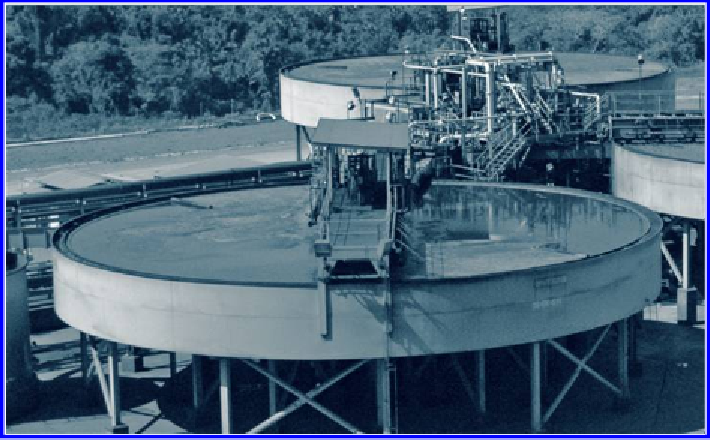Environmental Engineering Reference
In-Depth Information
FIGURE 4.18
Thickener Illustrated
Gravity causes the solids to settle to
the bottom of the thickener, where
they are scraped to a discharge outlet
by a slowly rotating rake.
amount of water placed in the pond and the pond size. The thickened tailings retain sufi -
cient water to allow them to l ow in the tailings pipeline without undue wear on the trans-
port system.
The settling of solids in the thickeners is often enhanced by chemical reagents known as
l occulants. Filter cake moisture is regulated by reagents known as i ltering agents. Typical
l occulants and i ltering agents used are polymers, nonionic surfactants, polyacrylate, and
anionic and nonionic polyacrylamides (ASARCO 1991).
Concentrate Storage and Shipping
The i nal mine product is shipped to downstream mineral processing for further treat-
ment, or as in coal mining to the end user. Concentrate transportation is by truck, con-
veyor belt, pipeline, railway, ship, or a combination of those. In view of environmental
concerns, concentrate and coal transportation to the downstream industry or the end user
differ in one particular aspect to movement of waste rock or tailings - the transportation
corridor is often outside the actual mine site, may stretch over tens of kilometres, and may
interfere with public transportation or land uses (
Case 4.6
). If the existing public transpor-
tation infrastructure is used, additional trafi c due to ore transport will increase noise, dust,
and gaseous emission, and will decrease road safety. Newly established transportation cor-
ridors require land acquisition with related environmental and social issues. Concentrate
transportation in pipelines is a preferred solution on environmental grounds, but requires
high initial capital commitment. Concentrates are transported in slurry and dewatering at
the port site is required. Efl uent discharge becomes an environmental issue. Independent
of the mode of transportation, there is always the need for storage for concentrate or coal.
If not protected against rain by shelters, runoff water or leachate from such storage areas
may cause water pollution.
Precious metals and precious stones such as diamonds provide a special case. Here,
the product is highly valuable but occupies relatively little space. Security against theft is
a major consideration. As a result, precious commodities are usually transported by air
rather than by land or over water.
The transportation corridor is
often outside the actual mine
site, may stretch over tens of
kilometres, and may interfere
with public transportation or
land uses.










Search WWH ::

Custom Search